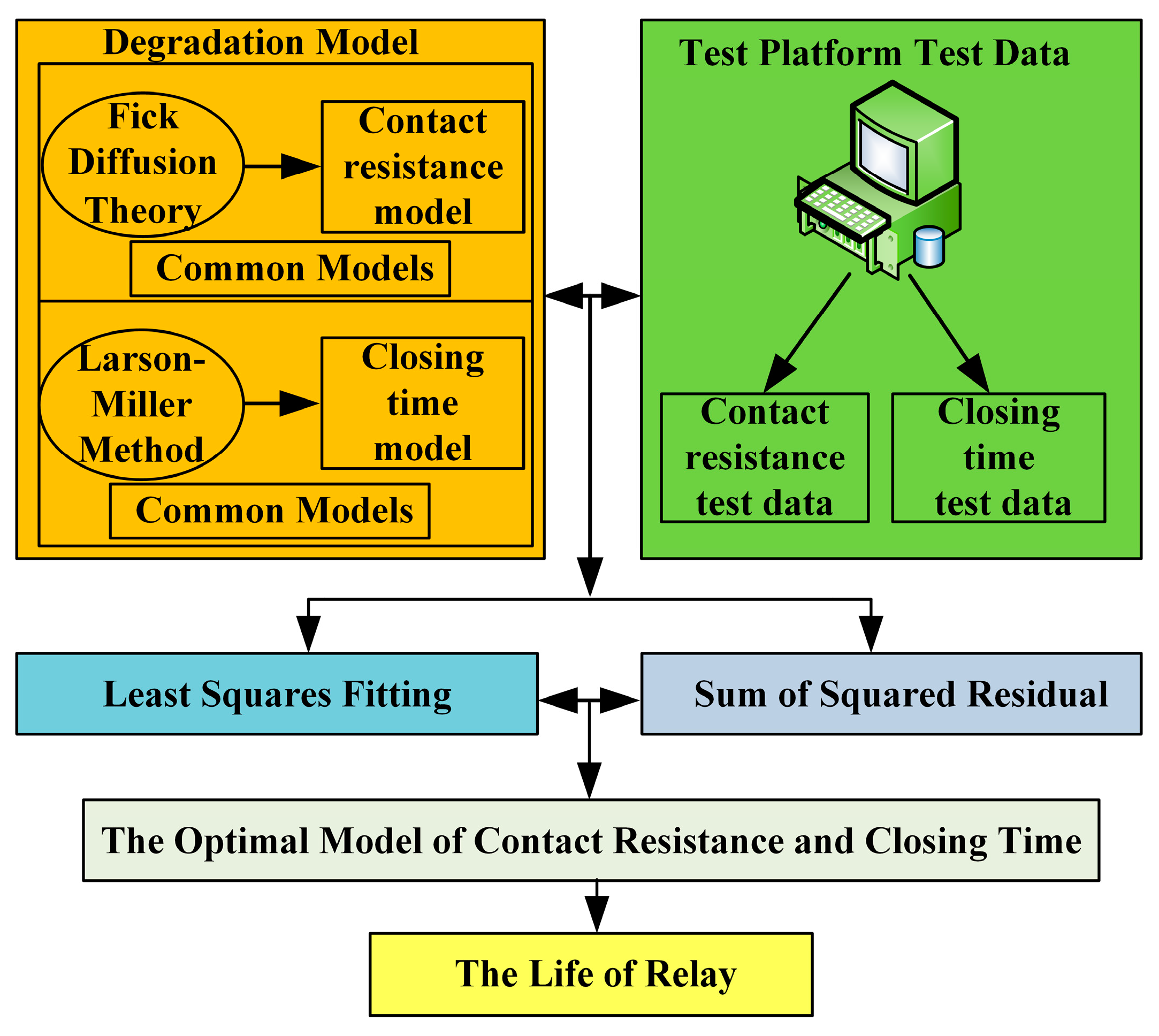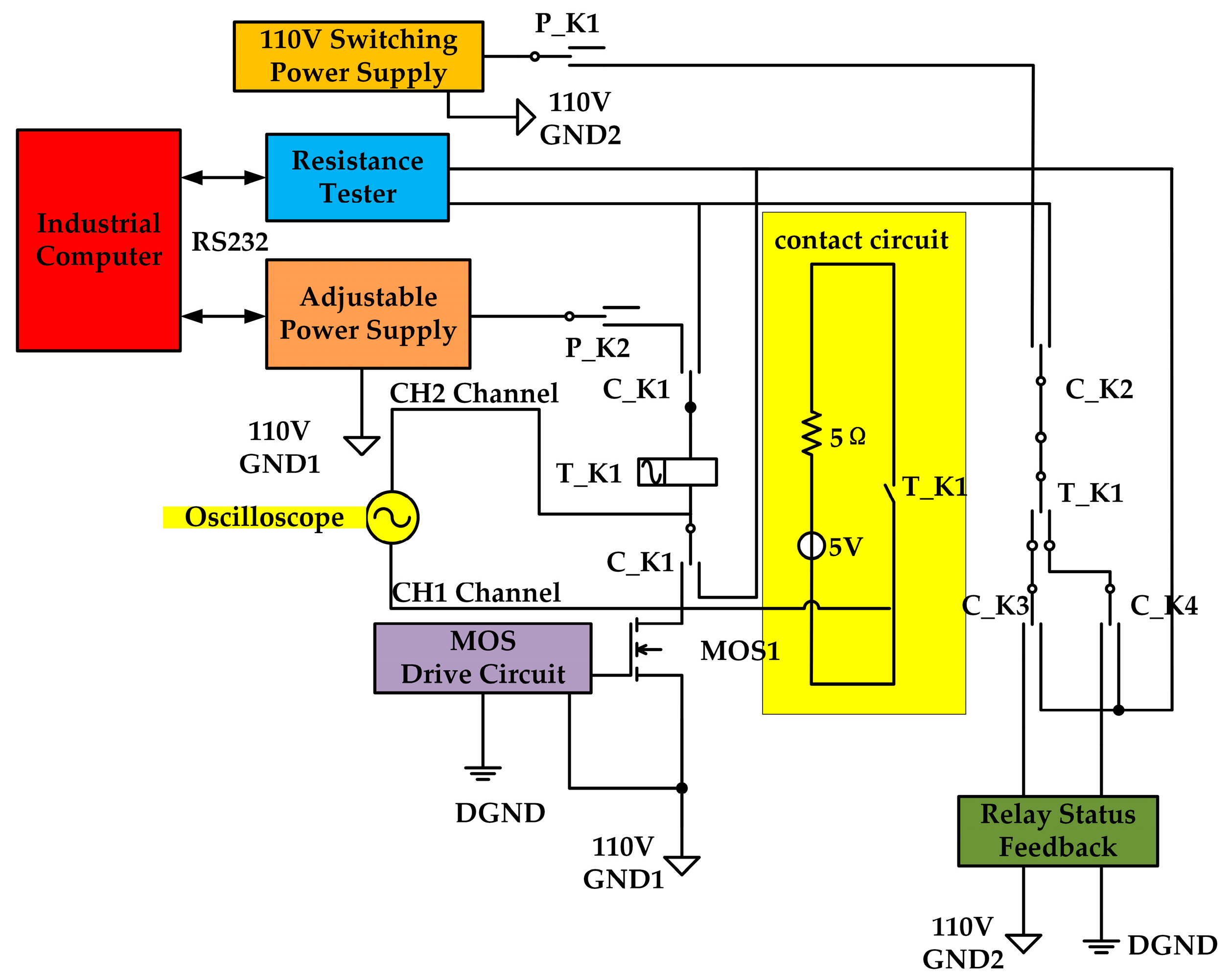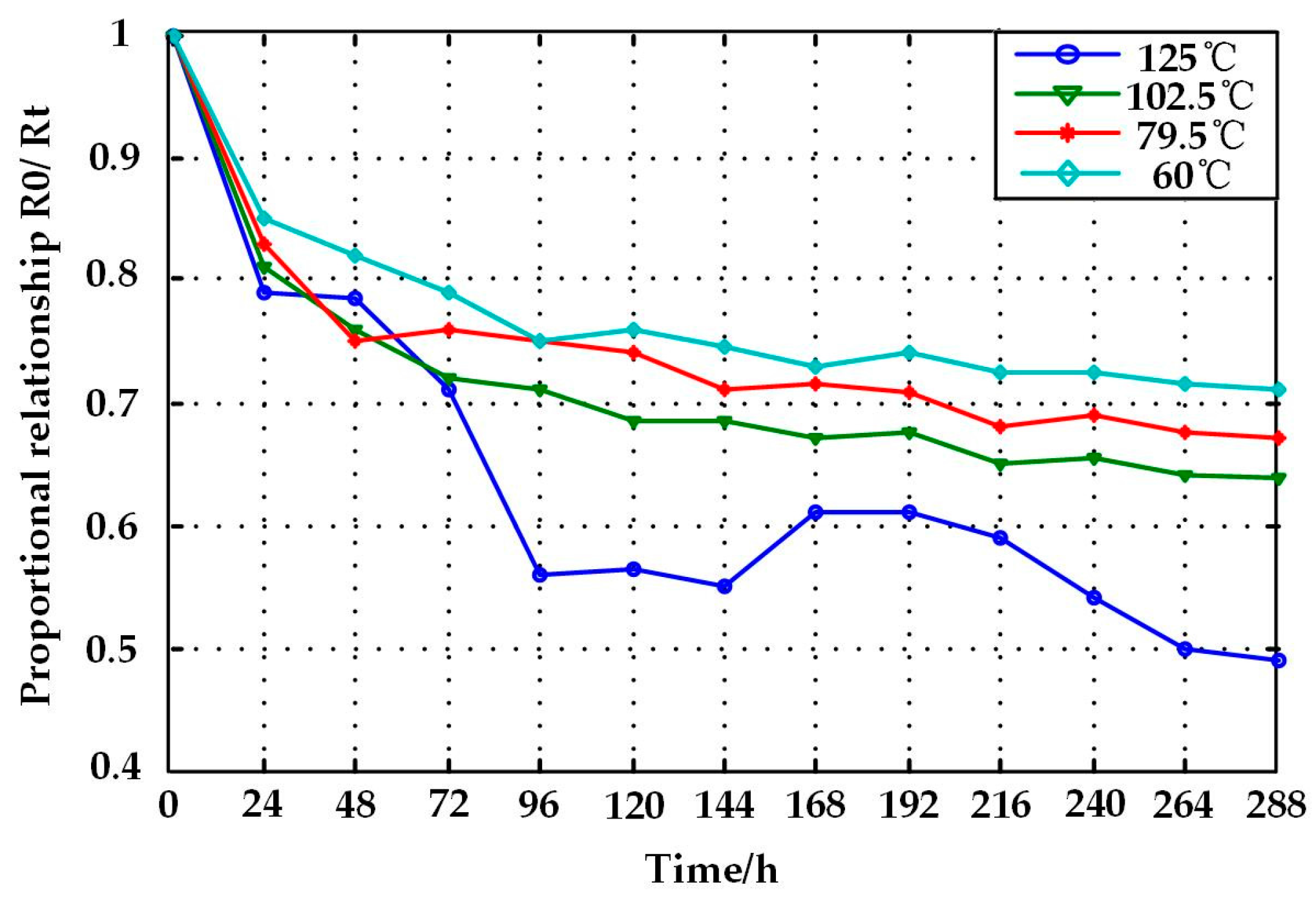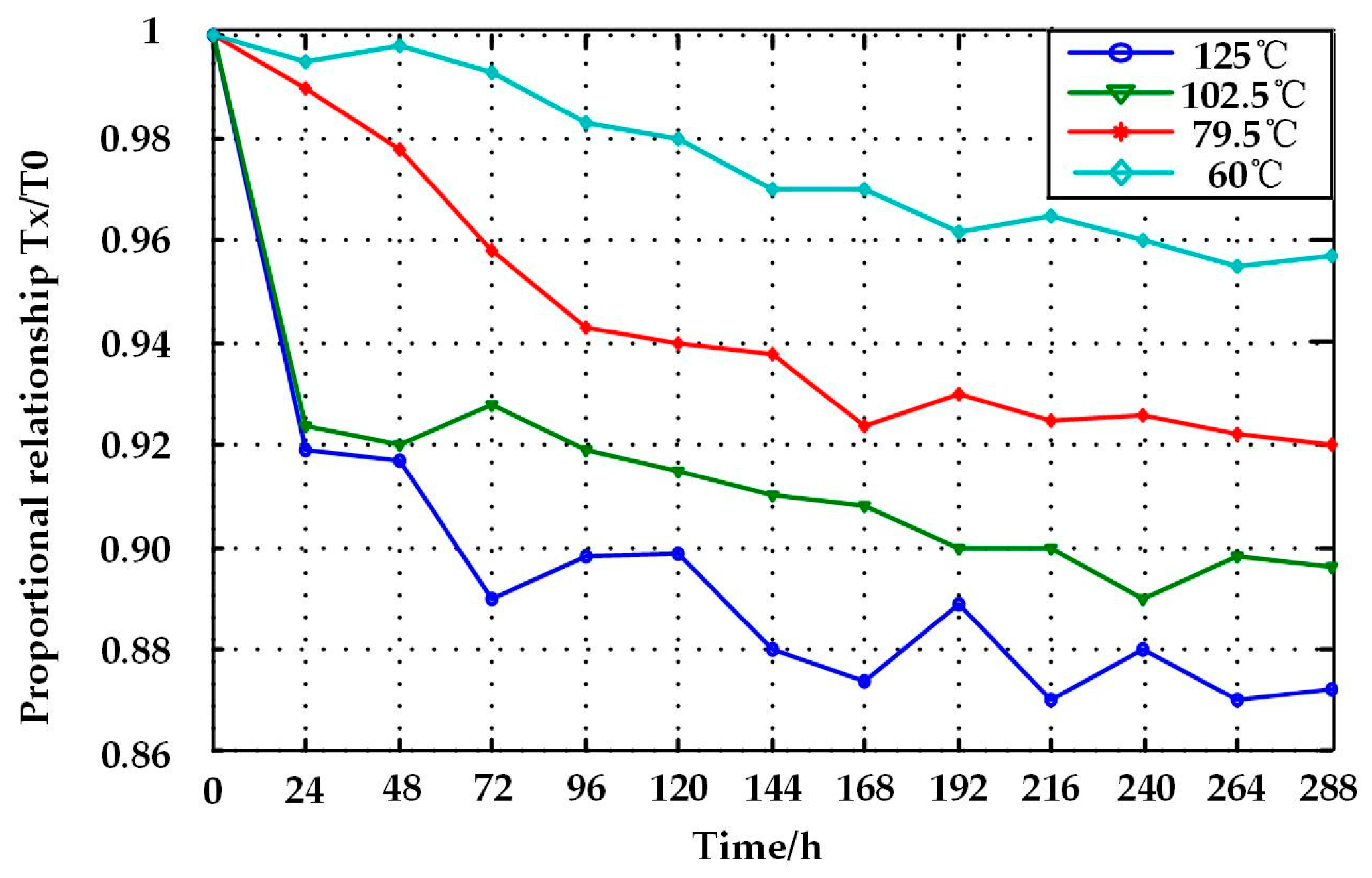A Reliability Assessment Method for High Speed Train Electromagnetic Relays
Abstract
:1. Introduction
2. Failure Mechanism
2.1. Common Failure Mechanisms
2.2. Failure Mechanism Analysis
3. Degradation Model
3.1. Degradation Model of Contact Resistance
3.2. Degradation Model of Closing Time
3.3. Common Model
- (1)
- Linear function:
- (2)
- Parabolic function:
- (3)
- Exponential function:
- (4)
- Power function:
- (5)
- Logarithmic function:
4. Reliability Life Test
4.1. Reliability Assessment Method
4.2. Test Platform
4.3. Stress Analysis
4.4. Methods for Test Systems
4.4.1. Test Method of Contact Resistance
4.4.2. Closing Time Test Method
5. Life Prediction of Electromagnetic Relay
5.1. Test Result of Characteristic Parameter
5.1.1. Test Result of Contact Resistance
5.1.2. Test Result of Closing Time
5.2. Fitting Result
- (1)
- The contact resistance is more than doubled, which is , when the relay has failed.
- (2)
- The closing time is less than 0.85, which is , when the relay has failed.
5.3. Reliability Assessment
6. Conclusions
Acknowledgments
Author Contributions
Conflicts of Interest
References
- Huang, J.; Strunk, H.P.; Wasserbäch, W. Internally oxidized silver contact materials—A case for the elastoplasticity of an inhomogeneous body. Cryst. Res. Technol. 2010, 44, 1147–1155. [Google Scholar] [CrossRef]
- Wu, C.P.; Yi, D.Q.; Xu, C.H. Microstructure of internally oxidized layer in Ag–Sn–Cu alloy. Corros. Sci. 2008, 50, 3508–3518. [Google Scholar] [CrossRef]
- Tamai, T. Effect of humidity on growth of oxide film on surface of copper contacts. IEICE Trans. Electron. 2007, 90, 1391–1397. [Google Scholar] [CrossRef]
- Read, M.B.; Lang, J.H.; Slocum, A.H. Contact resistance in flat thin films. In Proceedings of the 55th IEEE Holm Conference on Electrical Contacts, Vancouver, BC, Canada, 14–16 September 2009. [Google Scholar]
- Ye, X.; Yu, Q.; Zhai, G. Reliability assessment for electromagnetic relay based on time parameters degradation. In Proceedings of the International Conference on Electronic Packaging Technology & High Density Packaging, Xi’an, China, 16–19 August 2010; pp. 1269–1272. [Google Scholar]
- Lu, J.G.; Luo, Y.Y.; Li, W.H.; Meng, F.B.; Wang, L.Z. Storage Life Test and Failure Analysis of Aerospace Relays. Trans. China Electrotech. Soc. 2009, 24, 54–59. [Google Scholar]
- Wang, Z.; Zhai, G.; Ren, W.; Huang, X.; Yu, Q. Research on Accelerated Storage Degradation Testing for Aerospace Electromagnetic Relay. In Proceedings of the IEEE Holm Conference on Electrical Contacts, Portland, OR, USA, 23–26 September 2012; pp. 1–8. [Google Scholar]
- Kenmotsu, T.; Miyamoto, N.; Wada, M. Erosion of Extraction Electrodes of Ion Sources due to Sputtering. AIP Conf. Proc. 2011, 1321, 325–328. [Google Scholar] [CrossRef]
- Wang, Z.; Huang, Z.; Wang, J.; Shang, S.; Zhai, G. The failure mechanism of electromagnetic relay in accelerated storage degradation testing. In Proceedings of the IEEE Holm Conference on Electrical Contacts, Denver, CO, USA, 10–13 September 2017; pp. 164–168. [Google Scholar]
- Chen, Z.K.; Zheng, S. Lifetime distribution based degradation analysis. IEEE Trans. Reliab. 2005, 54, 3–10. [Google Scholar] [CrossRef]
- Wang, Z.H.; Fu, H.M.; Zhang, Y.B. Linear independent increment process with linear standard deviation function for degradation analysis. In Proceedings of the 10th International Conference on Applied Sciences & Technology, Islamabad, Pakistan, 15–19 January 2013. [Google Scholar]
- Ringsted, C.; Lippert, F.; Hesselfeldt, R. Assessment of advanced life support competence when combining different test methods—Reliability and validity. Resuscitation 2007, 75, 153–160. [Google Scholar] [CrossRef] [PubMed]
- Ma, H.; Meeker, W.Q. Optimum step-stress accelerated life test plans for log-location-scale distributions. Nav. Res. Logist. 2008, 55, 551–562. [Google Scholar] [CrossRef]
- Wang, S.; Yu, Q.; Ren, L.; Ren, W. Study on contact failure mechanisms of accelerated life test for relay reliability. IEICE Trans. Electron. 2009, 92, 1034–1039. [Google Scholar] [CrossRef]
- Chen, Z.K.; Witter, G.J. The effect of silver composition and additives on switching characteristics of silver tin oxide type contacts for automotive inductive loads. In Proceedings of the 51st IEEE Holm Conference on Electrical Contacts, Chicago, IL, USA, 26–28 September 2005; pp. 35–41. [Google Scholar]
- Behzad, M.; Arghan, H.A.; Bastami, A.R.; Zuo, M.J. Prognostics of rolling element bearings with the combination of paris law and reliability method. In Proceedings of the Prognostics and System Health Management Conference, Harbin, China, 9–12 July 2017; pp. 1–6. [Google Scholar]
- Xing, Y.; Williard, N.; Tsui, K.L.; Pecht, M. A comparative review of prognostics-based reliability methods for Lithium batteries. In Proceedings of the Prognostics and System Health Managment Confernece, Shenzhen, China, 24–25 May 2011; pp. 1–6. [Google Scholar]
- Hong, Y.F.; Liu, Z.Q.; Yin, H.X.; Zhang, J.H. A New Method for Smart Grid Reliability. In Proceedings of the Asia-Pacific Power and Energy Engineering Conference, Wuhan, China, 25–28 March 2011; pp. 1–4. [Google Scholar]
- Luo, Y.Y.; Lu, J.G.; Li, W.H. Study on the Accelerated Life Test of Storage Life for Sealed Electromagnetic Relays. Acta Armamentarll 2007, 28, 997–1001. [Google Scholar] [CrossRef]
- Chen, H.; Feng, F.; Qu, T.M. The Influence of Gas Flow Rate on the Growth of YBCO Films Prepared by TFA-MOD. IEEE Trans. Appl. Superconduct. 2009, 19, 3123–3126. [Google Scholar] [CrossRef]
- Wang, Z.B.; Fu, S.; Shang, S. New forecasting method of closing time for aerospace relay in storage accelerated degradation testing. In Proceedings of the 11th International Conference on Reliability, Maintainability and Safety (ICRMS), Hangzhou, China, 26–28 October 2016. [Google Scholar] [CrossRef]
- Malucci, R.D. Dynamic model of stationary contacts based on random variations of surface features. IEEE Trans. Compon. Hybrids Manuf. Technol. 1992, 15, 339–347. [Google Scholar] [CrossRef]
- Daniel, J.D.; Michael, T.D. Electrical Contact Resistance Degradation of a Hot-Switched Simulated Metal MEMS Contact. IEEE Trans. Compon. Packag. Technol. 2007, 30, 75–80. [Google Scholar] [CrossRef]
- Di, J.; Guo, S.; Cai, L. Enhanced corrosion resistance of sintered NdFeB magnets by diffusion of Co film prepared by direct current magnetron sputtering deposition. In Proceedings of the IEEE International Magnetics Conference, Beijing, China, 11–15 July 2015. [Google Scholar]
- Brian, G.M.; Eitan, A.; Marc, P.D.; Dennis, K. Failure mechanisms of legacy aircraft wiring and interconnects. IEEE Trans. Dielectr. Electr. Insul. 2008, 15, 184–185. [Google Scholar] [CrossRef]
- Galvele, J. A stress corrosion cracking mechanism based on surface mobility. Corros. Sci. 1987, 27, 1–33. [Google Scholar] [CrossRef]
- Mukherjee, M.; Chakravorti, S. Assessment of moisture diffusion distance in pressboard insulation within transformer using Fick’s law. In Proceedings of the 18th National Power Systems Conference, Guwahati, India, 18–20 December 2014. [Google Scholar]
- Wu, J.G.; Li, H.B.; Zheng, D.Q. Storage durability life and reliability analysis of welded metal bellows. In Proceedings of the 9th International Conference on Reliability, Maintainability and Safety, Guiyang, China, 12–15 June 2011. [Google Scholar]










| Stress Type | Failure Mechanism | Failure Manifestation |
|---|---|---|
| Temperature | Oxidation, heat-aging | Contact resistance increase |
| Moisture | Adsorption, infiltration | Accelerated corrosion |
| Vibration | Loosening, abrasion | Mechanical damage |
| Other | Atmospheric corrosion | Contact resistance increase |
| Relay Number | Contact Resistance Model | Linear Function | Parabolic Function | Exponential Function | Power Function | Logarithmic Function |
|---|---|---|---|---|---|---|
| 1 | 0.1228 | 0.1103 | 0.1098 | 0.1102 | 0.1081 | 0.1082 |
| 2 | 0.2743 | 0.1356 | 0.1356 | 0.1365 | 0.1810 | 0.1689 |
| 3 | 0.0719 | 0.0818 | 0.0683 | 0.0789 | 0.0575 | 0.0596 |
| 4 | 0.5181 | 0.3802 | 0.3373 | 0.3683 | 0.2657 | 0.2407 |
| 5 | 0.0260 | 0.0408 | 0.0163 | 0.0365 | 0.0065 | 0.0041 |
| 6 | 0.2051 | 0.2321 | 0.0783 | 0.3776 | 0.4118 | 0.2236 |
| 7 | 0.00388 | 0.00095 | 0.00077 | 0.00102 | 0.00853 | 0.008385 |
| 8 | 0.00156 | 0.00133 | 0.00133 | 0.00133 | 0.00254 | 0.00252 |
| 9 | 0.0245 | 0.0336 | 0.0176 | 0.0311 | 0.0044 | 0.0030 |
| 10 | 0.00914 | 0.00557 | 0.0049 | 0.005332 | 0.02264 | 0.02187 |
| 11 | 0.0086 | 0.00212 | 0.000849 | 0.002293 | 0.01461 | 0.01443 |
| 12 | 0.0123 | 0.01133 | 0.01113 | 0.01133 | 0.01097 | 0.01097 |
| 13 | 0.0148 | 0.0249 | 0.0092 | 0.0228 | 0.0047 | 0.0033 |
| 14 | 0.0735 | 0.1052 | 0.0736 | 0.4368 | 0.2578 | 0.0496 |
| 15 | 0.26719 | 0.2811 | 0.3526 | 0.1739 | 0.2505 | 0.0721 |
| 16 | 0.1856 | 0.2369 | 0.5546 | 0.0896 | 0.2554 | 0.1069 |
| SUM | 1.81927 | 1.6838 | 1.772179 | 1.883505 | 1.86269 | 1.098175 |
| Temperature | Degradation Model | Failure Threshold | Life Prediction |
|---|---|---|---|
| 125 °C | 46 | ||
| 102.5 °C | 124 | ||
| 79.5 °C | 338 | ||
| 60 °C | 830 |
| Relay Number | Closing Time Model | Linear Function | Parabolic Function | Exponential Function | Power Function | Logarithmic Function |
|---|---|---|---|---|---|---|
| 1 | 0.0106 | 0.0103 | 0.0063 | 0.0102 | 0.0108 | 0.0106 |
| 2 | 0.0071 | 0.0028 | 0.0026 | 0.0028 | 0.0072 | 0.0071 |
| 3 | 0.0032 | 0.0029 | 0.0024 | 0.0029 | 0.0033 | 0.0032 |
| 4 | 0.0042 | 0.0013 | 0.0011 | 0.0013 | 0.0043 | 0.0042 |
| 5 | 0.00033 | 0.0038 | 0.0025 | 0.0037 | 0.000346 | 0.00033 |
| 6 | 0.0035 | 0.0058 | 0.0039 | 0.0055 | 0.0074 | 0.0035 |
| 7 | 0.0056 | 0.0072 | 0.0049 | 0.0037 | 0.0066 | 0.0056 |
| 8 | 0.0033 | 0.0208 | 0.0325 | 0.0213 | 0.0095 | 0.0033 |
| 9 | 0.0025 | 0.0015 | 0.0002 | 0.0014 | 0.0026 | 0.0025 |
| 10 | 0.0021 | 0.0002 | 0.0002 | 0.00023 | 0.002146 | 0.0021 |
| 11 | 0.0024 | 0.0008 | 0.0008 | 0.00075 | 0.00238 | 0.00235 |
| 12 | 0.0011 | 0.0009 | 0.0009 | 0.00086 | 0.0011 | 0.0011 |
| 13 | 0.0018 | 0.0001 | 0.0009 | 0.00011 | 0.0018 | 0.0088 |
| 14 | 0.0095 | 0.0127 | 0.0296 | 0.0253 | 0.0377 | 0.0095 |
| 15 | 0.0078 | 0.0093 | 0.0059 | 0.0103 | 0.0145 | 0.0078 |
| 16 | 0.0069 | 0.0117 | 0.0031 | 0.0136 | 0.0038 | 0.0099 |
| SUM | 0.071881 | 0.09206 | 0.0969 | 0.10394 | 0.115472 | 0.08188 |
| Temperature | Degradation Model | Failure Threshold | Life Prediction |
|---|---|---|---|
| 125 °C | 62 | ||
| 102.5 °C | 174 | ||
| 79.5 °C | 286 | ||
| 60 °C | 902 |
| Temperature Stress | Life Prediction |
|---|---|
| 25 °C | 11,874 |
| 30 °C | 8245 |
| 35 °C | 5793 |
© 2018 by the authors. Licensee MDPI, Basel, Switzerland. This article is an open access article distributed under the terms and conditions of the Creative Commons Attribution (CC BY) license (http://creativecommons.org/licenses/by/4.0/).
Share and Cite
Liu, J.; Zhang, M.; Zhao, N.; Chen, A. A Reliability Assessment Method for High Speed Train Electromagnetic Relays. Energies 2018, 11, 652. https://doi.org/10.3390/en11030652
Liu J, Zhang M, Zhao N, Chen A. A Reliability Assessment Method for High Speed Train Electromagnetic Relays. Energies. 2018; 11(3):652. https://doi.org/10.3390/en11030652
Chicago/Turabian StyleLiu, Jianqiang, Ming Zhang, Nan Zhao, and Aifeng Chen. 2018. "A Reliability Assessment Method for High Speed Train Electromagnetic Relays" Energies 11, no. 3: 652. https://doi.org/10.3390/en11030652
APA StyleLiu, J., Zhang, M., Zhao, N., & Chen, A. (2018). A Reliability Assessment Method for High Speed Train Electromagnetic Relays. Energies, 11(3), 652. https://doi.org/10.3390/en11030652






